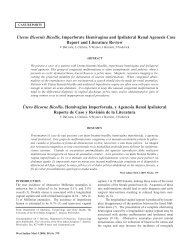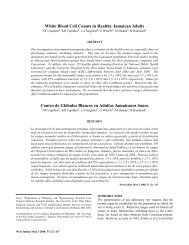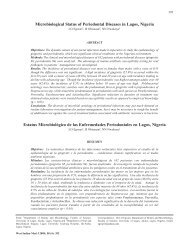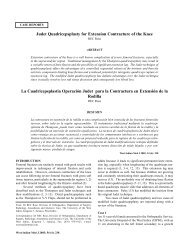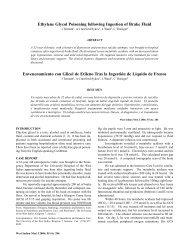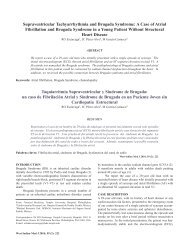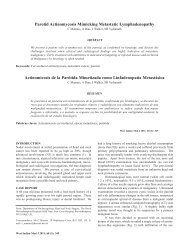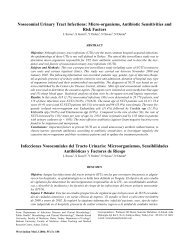Dr Harriott.qxp - West Indian Medical Journal
Dr Harriott.qxp - West Indian Medical Journal
Dr Harriott.qxp - West Indian Medical Journal
You also want an ePaper? Increase the reach of your titles
YUMPU automatically turns print PDFs into web optimized ePapers that Google loves.
A Randomized Comparison of Rectal Misoprostol with Syntometrine on Blood Loss<br />
in the Third Stage of Labour<br />
J <strong>Harriott</strong> 1 , L Christie 1 , S Wynter 1 , V DaCosta 1 , H Fletcher 1 , M Reid 2<br />
<strong>West</strong> <strong>Indian</strong> Med J 2009; 58 (3): 201<br />
ABSTRACT<br />
Objectives: a) To compare the clinical effect of rectal misoprostol with intramuscular syntometrine in<br />
reducing blood loss in the third stage of labour, b) to determine the severity and incidence of side effects<br />
of both drugs and c) to measure blood loss, patient tolerance and acceptance of rectal misoprostol.<br />
Methods: One hundred and forty parturients were randomly allocated to receive intramuscular<br />
syntometrine (syntocinon 10 IU + ergometrine 0.5 mg) or rectal misoprostol 400 ?g within five minutes<br />
of the delivery of the anterior shoulder. Blood loss was measured by the use of a plastic collection<br />
drape. Additional oxytocic therapy was instituted for uterine atony or if blood loss was in excess of one<br />
litre.<br />
Results: There was no significant difference in patient demographics of each treatment group<br />
(Table 1). There was no difference in mean duration of the third stage of labour (8.4 ± 14 min vs<br />
7.8 ± 6.6 min). The mean blood loss from those parturients receiving misoprostol (180.1 ± 120 mls)<br />
was not significantly different (p = 0.5) from those receiving syntometrine (197 ± 176.97 mls) for the<br />
active management of the third stage of labour. Treatment with syntometrine was associated with a<br />
significant elevation of post-partum systolic blood pressure compared with misoprostol treatment (mean<br />
increase 0.57 ± 18.79 mmHg vs -1.43 ± 14.17 mmHg, (mean ± SD), p < 0.04). Rectal misoprostol was<br />
well tolerated in 88.5% of participants, 11.4% reported that insertion was uncomfortable, of which<br />
2.8% reported that they would have preferred parenteral drug administration.<br />
Conclusion: The clinical effect of rectal misoprostol and intramuscular syntometrine were not different<br />
at the doses used in the active management of the third stage of labour in this study. Rectal misoprostol<br />
was well tolerated by the patients and had a low side effect profile. Blood loss assessment using the<br />
blood collection drape is of invaluable benefit in resource-poor settings.<br />
Comparación Randomizada del Misoprostol Rectal con la Sintometrina en la<br />
Pérdida de Sangre en la Tercera etapa del Parto<br />
J <strong>Harriott</strong> 1 , L Christie 1 , S Wynter 1 , V DaCosta 1 , H Fletcher 1 , M Reid 2<br />
RESUMEN<br />
Objetivos: a) Comparar el efecto clínico del misoprostol rectal con la sintometrina intramuscular en la<br />
reducción de la pérdida de sangre en la tercera etapa del parto, b) determinar la severidad y la<br />
incidencia de los efectos colaterales de ambos medicamentos, y c) medir la pérdida de sangre, la<br />
tolerancia de las pacientes y la aceptación del misoprostol rectal.<br />
Métodos: Ciento cuarenta parturientas fueron elegidas de forma aleatoria para que recibieran la<br />
sintometrina intramuscular (syntocinon 10 IU + ergometrina 0.5 mg) o el misoprostol rectal 400 µg<br />
dentro de los cinco minutos de la salida del hombro anterior. Se midió la pérdida de sangre usando una<br />
bolsa plástica de recolección de sangre. Se instituyó una terapia oxitócica adicional para la atonía<br />
uterina o para el caso de que la pérdida de sangre excediera un litro.<br />
Resultados: No hubo diferencia significativa en la demografía de los pacientes de cada grupo de<br />
tratamiento (tabla 1). No hubo diferencia en la duración promedio de la tercera etapa del parto (8.4 ±<br />
14 min vs 7.8 ± 6.6 min). La pérdida promedio de sangre de las parturientas que recibieron el miso-<br />
From: 1 Department of Obstetrics and Gynaecology, University Hospital of<br />
the <strong>West</strong> Indies, Kingston7, Jamaica and 2 Tropical Medicine Research<br />
Institute, The University of the <strong>West</strong> Indies, Kingston 7, Jamaica, <strong>West</strong><br />
Indies.<br />
Correspondence: <strong>Dr</strong> J <strong>Harriott</strong>, Department of Obstetrics and Gynaecology,<br />
University Hospital of the <strong>West</strong> Indies, Kingston 7, Jamaica. Fax (876) 970-<br />
4558; e-mail: johnharriott02@uwimona.edu.jm
202 Rectal Misoprostol and Blood Loss<br />
prostol (180.1 ± 120 mls) no fue significativamente diferente (p = 0.5) de las que recibieron sintometrina<br />
(197 ± 176.97 mls) para el tratamiento activo de la tercera etapa del parto. El tratamiento con<br />
sintometrina estuvo asociado con una elevación significativa de la presión sistólica postparto<br />
comparada con el tratamiento con misoprostol (aumento promedio 0.57 ± 18.79 mmHg vs -1.43 ± 14.17<br />
mmHg, (media ± sd), p < 0.04). El misoprostol rectal fue bien tolerado por el 88.5% de las participantes,<br />
11.4% reportaron que la inserción fue incómoda, y de ellas 2.8% reportó que hubieran preferido<br />
una administración parenteral del medicamento.<br />
Conclusión: El efecto clínico del misoprostol rectal y el de la sintometrina intramuscular, no fueron<br />
diferentes en las dosis usadas en el tratamiento activo de la tercera etapa del parto en este estudio. El<br />
misoprostol rectal fue bien tolerado por las pacientes y tuvo un perfil de efecto colateral bajo. La<br />
evaluación de la pérdida de sangre utilizando una bolsa de recolección de sangre posee un valor<br />
inapreciable en escenarios de recursos pobres.<br />
<strong>West</strong> <strong>Indian</strong> Med J 2009; 58 (3): 202<br />
INTRODUCTION<br />
Post-partum haemorrhage (PPH) accounts for approximately<br />
28% of maternal deaths in developing countries (1), equivalent<br />
to 100 deaths per 100 000 deliveries (2); 13% of maternal<br />
deaths in the United States of America [USA] (3) and one<br />
death per 100 000 deliveries in Britain (2). In Jamaica, postpartum<br />
haemorrhage (PPH) accounted for 12 deaths per<br />
100 000 deliveries in the triennia 1993–1995 (McCaw-Binns<br />
et al, personal communication, Jamaica). In addition, it is a<br />
significant contributor to maternal morbidity (3, 4).<br />
At the University Hospital of the <strong>West</strong> Indies (UHWI),<br />
the active management of the third stage of labour protocol<br />
relies primarily on pharmacotherapy as prophylaxis against<br />
PPH. Meta-analysis of controlled trials suggests that oxytocics<br />
reduce post-partum haemorrhage rates from 10 per cent<br />
to 6 per cent (5). Despite the use of available drugs (oxytocin,<br />
syntometrine and methylergonovine maleate) in a timely<br />
fashion, significant haemorrhage continues to be a threat to<br />
maternal well-being (2).<br />
Prostaglandins have proven value in the management<br />
of PPH even in cases not responding to syntometrine/<br />
oxytocin (6 – 8). However, the ideal route of administration<br />
and the optimal dose has not been established. Numerous<br />
studies advocating the off-label use of misoprostol (Cytotec;<br />
Searle AG, Chicago, IL) have shown varying efficacy based<br />
on the route of administration and dose used (9 – 13). The<br />
pharmacokinetics suggest that the median onset of action of<br />
oral misoprostol (6.0 min, range 4.0 – 10.0 min) is significantly<br />
more rapid than by the rectal route (11.0 min, range<br />
7.0 – 13.0 min) resulting in earlier clinical efficacy (14). In<br />
practice, rectal misoprostol offers a longer duration of sustained<br />
uterine contractility even though its onset of action is<br />
slower.<br />
Conventional oxytocics (syntometrine, oxytocin) are of<br />
little value in resource-poor countries where refrigeration is<br />
not readily available as they require storage at 2 – 8°C and<br />
are degraded by heat and light. In contrast, misoprostol is<br />
easily stored at room temperature, not degenerated by light or<br />
heat, is relatively inexpensive and has good transmucosal<br />
absorption (13) and relatively few side effects.<br />
Other distinct advantages of the rectal route include its<br />
post-partum administration in patients with vomiting (which<br />
is not an uncommon intrapartum event) and in those unable<br />
to take medications due to anaesthesia. In addition, rectal<br />
misoprostol is associated with less systemic side-effects (14)<br />
and can be appropriately used in the domiciliary setting<br />
where parenteral access may not be an option.<br />
We therefore sought to determine the clinical effect of<br />
rectal misoprostol compared with syntometrine in reducing<br />
blood loss in the third stage of labour at the UHWI, Jamaica.<br />
SUBJECTS AND METHODS<br />
This prospective open randomized controlled trial was<br />
conducted on the labour ward at the UHWI, Jamaica, over a<br />
period of six months to compare the clinical effect of rectally<br />
administered misoprostol (400 µg) and syntometrine in the<br />
management of the third stage of labour, to determine the<br />
severity and incidence of side effects of both drugs and to<br />
establish patient tolerance and acceptance of rectally administered<br />
misoprostol. The study was approved by the<br />
Ethics Committee of the Faculty of <strong>Medical</strong> Sciences, University<br />
of the <strong>West</strong> Indies/University Hospital of the <strong>West</strong><br />
Indies.<br />
The participants were counselled and written informed<br />
consent obtained from one hundred and forty parturients.<br />
Exclusion criteria included previous post-partum haemorrhage,<br />
hypertensive disorders, previous Caesarean section, intrauterine<br />
death in current pregnancy, sepsis/pyrexia > 38°C,<br />
antepartum haemorrhage, symptomatic anaemia or haemoglobin<br />
below 8 g/dL.<br />
Computer generated block randomization was used to<br />
randomly assign participants to receive pharmacotherapy<br />
(syntometrine versus misoprostol) for the active management<br />
of the third stage of labour. Both the patient and the midwife<br />
conducting the delivery were aware of the drug administered.<br />
The main outcome parameter was measured blood loss<br />
up to one hour post-delivery. Secondary outcome measures<br />
included the proportion of subjects with post-partum<br />
haemorrhage, the proportion of subjects who need additional<br />
utero-tonic agents and incidence of adverse events.
On arrival at the labour ward, a blood sample for<br />
haemoglobin and haematocrit was collected at insertion of an<br />
intravenous access. When vaginal delivery was imminent the<br />
parturient was assigned a study number generated by computer<br />
block randomization. The pharmacotherapeutic agent<br />
administered was based on the assigned number being either<br />
intravenous syntometrine or rectally administered misoprostol.<br />
The uterotonic agent was given within five minutes of<br />
delivery of the anterior shoulder by an accoucheur not<br />
involved in the delivery.<br />
Additional therapeutic uterotonics were adminis-tered<br />
when there was clinical evidence of poor uterine tone post<br />
delivery or in the presence of uterine haemorrhage in excess<br />
of one litre (Table 2). Intravenous methylergonovine maleate<br />
0.2 mg was given initially and if necessary a slow<br />
intravenous infusion of syntocinon 20 U in 500mls dextrose<br />
water was administered.<br />
Blood loss was measured by use of a modified plastic<br />
collection drape which was placed beneath the parturient.<br />
The collection drape measured 168 cm x 84 cm, contained<br />
folded over side-wings and a 34-cm collection pouch (Figs. 1<br />
– 4). The side wings acted as a chute for the collection of all<br />
Fig. 1: Placement of the blood collection drape on delivery<br />
bed.<br />
Fig. 2: Sterile drapes overlying collection drapes at delivery.<br />
<strong>Harriott</strong> et al<br />
Fig. 3: Sterile drapes moved away to allow blood to be<br />
collected by plastic drape.<br />
Fig. 4: Graduated measuring cylinder used for quantifying<br />
blood loss.<br />
203<br />
blood lost at the time of delivery into the collection pouch<br />
made by folding the distal end of the drape. The usual sterile<br />
drapes were placed above the blood collection drape. Prior<br />
to delivery of the fetus every effort was made to avoid soiling<br />
of the sterile drapes as these were not weighed.<br />
Post-delivery, the sterile drape overlying the collection drape<br />
was removed to facilitate the use of the collection drape.<br />
Post-partum blood loss was measured from the commencement<br />
of the third stage up to one hour following delivery.<br />
One hour after delivery, side effects were evaluated by<br />
the use of a questionnaire that documented subjective and objective<br />
parameters – nausea, vomiting, diarrhoea, hot flushes,<br />
fever, shivering, headache and vertigo. Concomitantly, the<br />
post delivery temperature and blood pressure were recorded.<br />
These were compared with the intrapartum recordings just<br />
prior to delivery. The haemoglobin and haematocrit were<br />
measured on day one after delivery.
204 Rectal Misoprostol and Blood Loss<br />
Data analysis<br />
Data analysis was conducted using STATA 7.0, College<br />
Station. The primary outcome measure in this study was the<br />
volume of postpartum haemorrhage. A sample size of 140<br />
with 70 patients in each group was required to detect a<br />
difference in blood loss of 50 mls with a power of 90%. This<br />
was computed based on a previous study (11) which showed<br />
a variance for blood loss of 92 mls in the misoprostol group.<br />
An intention to treat analysis strategy was employed.<br />
Clinical and haematological parameters were compared<br />
using t and chi-square tests and repeated measures of analysis<br />
of variance (ANOVA) as appropriate. A p value < 0.05 was<br />
considered significant.<br />
RESULTS<br />
All one hundred and forty participants completed the study,<br />
with 70 receiving rectal misoprostol and 70 receiving syntometrine.<br />
The clinical characteristics of the sample are seen in<br />
Table 1, which showed no difference in the variables measured<br />
between the two treatment groups. Similarly, comparison<br />
between groups by selected variables of labour (Table 2)<br />
Table 1: Demographic characteristics of participants of the study<br />
showed no statistically significant differences between<br />
treatment groups.<br />
For the purpose of this paper, PPH was defined as<br />
blood loss in excess of 500 mls (WHO) at the time of delivery<br />
or a significant fall in haematocrit > 10% 24 hours post<br />
delivery. There was no statistical difference in the incidence<br />
of post-partum haemorrhage 3/70 (4.3%) in the group given<br />
syntometrine and 1/70 (1.4%) in those receiving misoprostol<br />
(risk ratio 1.5 with 95% CI 0.84, 2.75). Overall PPH occurred<br />
in 4/140 (2.85%) of participants. Severe PPH ≥ 1000 mls<br />
occurred in one participant, 1/140 (0.7%), who was given<br />
syntometrine with a measured blood loss of 1000 mls. There<br />
was an equal requirement for therapeutic oxytocics in 6/70<br />
(8.6%) in both treatment groups. None of the patients in<br />
either treatment group required blood transfusion and there<br />
were no maternal deaths.<br />
Shivering was significantly higher in those receiving<br />
misoprostol (16.4%) as compared to those receiving syntometrine<br />
(8.6%). There were no cases of severe shivering and<br />
in affected parturients most cases resolved within 10 to 30<br />
minutes. Eighty-five per cent of parturients (20/23) in the<br />
Demographic Syntometrine Misoprostol<br />
Characteristics (1 ampoule) (400 ?g)<br />
Values Range Values Range p Value<br />
Maternal age *, years 27.4 ± 6.1 17 – 41 28 ± 5.9 16 – 42 NS<br />
Parity # 0 0 – 4 1 0 – 8 NS<br />
Gestational age *, week 39.1 ± 1.8 31.7 – 42.4 39.2 ± 1.2 32.4 – 42 NS<br />
* Data are presented as mean ± SD # Values are medians NS – not significant<br />
Table 2: Variables of labour by treatment group<br />
Syntometrine Misoprostol<br />
(1 ampoule) (400 ?g) p values<br />
Measured post-partum blood loss<br />
up to one hour post delivery, mls<br />
Measured post-partum blood loss<br />
197 ± 177 180.1 ± 120 NS<br />
> 500 mls (3) (1) NS<br />
3rd stage duration 8.4 ± 14 min 7.8 ± 6.6 min NS<br />
Spontaneous/Assisted labour (69/1) (67/3) NS<br />
Oxytocin used in 1st and 2nd stage<br />
Intravenous fluid used in labour,<br />
(32) (33) NS<br />
mls 752.1 ± 596.5 684 ± 613.3 NS<br />
Additional oxytocin after initial methergin (6) (6)<br />
infusion, mean dosage, IU 15 ± 8.4 13.3 ± 10.3 NS<br />
Perineal trauma: (epis/laceration) (22) (19) NS<br />
Manual removal of placenta (1) (0) NS<br />
Neonatal weight (kg) 3.3 ± 0.6 3.3 ± 0.4 NS<br />
Data are presented as mean ± standard<br />
deviation (SD) or absolute counts (N),<br />
NS – not significant, epis = episiotomy
misoprostol group who experienced shivering reported that it<br />
would not be a deterrent factor in their future choice of uterotonic<br />
agent. None of the participants in this study received<br />
epidural anaesthesia which is a well-recognized cause of<br />
shivering.<br />
Two participants in the study experienced tetanic uterine<br />
contractions causing severe lower abdominal pain one hour<br />
after rectal misoprostol insertion. Both cases were refractory<br />
to orally administered acetaminophen but responded to intramuscularly<br />
administered meperidine hydrochloride.<br />
The symptoms in the most adversely affected parturient<br />
persisted in excess of an hour. No tocolytic therapy was required<br />
to achieve relief from the pain.<br />
Nausea was experienced by three parturients (2.1%)<br />
and vomiting by one parturient (0.7%) who received syntometrine.<br />
None of the parturients who received misoprostol<br />
reported such symptoms. There were no reports of pyrexia<br />
(temperature > 38°C) or diarrhoea following misoprostol<br />
therapy.<br />
In this study, 12 parturients who received syntometrine<br />
had post-partum systolic blood pressure readings above 140<br />
mmHg. There was a statistically significant increase in the<br />
post-partum systolic blood pressure in those receiving syntometrine<br />
compared with those receiving misoprostol (Table<br />
3).<br />
Table 3: Mean differences between antepartum and post-partum clinical<br />
characteristics by treatment group.<br />
Variables Syntometrine Misoprostol p values<br />
Hb difference g/dL 0.56 ± 0.72 0.50 ± 0.77 NS<br />
Hct difference % 1.95 ± 2.65 1.34 ± 3.17 NS<br />
Temperature difference ?F -0.59 ± 1.15 -0.65 ± 1.17 NS<br />
Systolic BP difference mmHg -0.57 ± 18.79 1.43 ± 14.17 0.04<br />
Diastolic BP difference mmHg -1.72 ± 12.47 1.50 ± 11.74 NS<br />
Mean difference = (antepartum mean – post-partum mean) ± SD<br />
When participants were asked how well misoprostol<br />
was tolerated, only 8 (11.4%) reported that insertion was uncomfortable,<br />
of which 2 (2.8%) reported that they would<br />
have preferred parenteral drug administration. The remaining<br />
62 participants were either unaware of rectal insertion<br />
[24] (34.3%) or reported no discomfort [38] (54.2%).<br />
DISCUSSION<br />
In Jamaica, PPH is the third leading cause of maternal death<br />
(15) which remains largely preventable. Multivariate sensitivity<br />
analysis of the Kigoma study (Tanzania) and a Gambian<br />
study showed that rectal misoprostol (1000 µg) is effective<br />
in treating patients satisfying the criteria for post-partum<br />
haemorrhage (blood loss greater than 500 mls prior to administration<br />
of misoprostol) by preventing 1647 cases of severe<br />
PPH per 10 000 births (16). The findings of this study<br />
using a lower dose of misoprostol demonstrated that the<br />
clinical effect (post-partum blood loss) of rectal misoprostol<br />
<strong>Harriott</strong> et al<br />
205<br />
(400 µg) was similar to standard therapy for PPH prophylaxis,<br />
with minimal side effects and was well tolerated.<br />
These findings have been corroborated by several other<br />
studies (7, 11, 17).<br />
A strength of this study is that it highlights the use of a<br />
blood collection drape for measuring blood loss at delivery.<br />
This may be of potential benefit in the domiciliary setting<br />
where blood loss is often underestimated (18). Blood within<br />
the placental interstices and loss due to splash, spillage or<br />
soiling of delivery drapes is often underestimated. The presence<br />
of amniotic fluid admixed with blood has been shown<br />
to contribute to overestimation. In the present study group, a<br />
placental dish was used to collect any liquor drained during<br />
the intrapartum period to avoid overestimation.<br />
The major advantages of utilizing rectal misoprostol<br />
include its ease of administration, low side effect profile and<br />
its ability to be administered in patients experiencing vomiting<br />
during the intrapartum period; whereas oral misoprostol<br />
would have been ineffective. Chong et al have shown that<br />
doses of oral misoprostol above 400µg were associated with<br />
significant shivering and pyrexia (60%). Side effects are<br />
related to the peak plasma concentrations of misoprostol acid<br />
achieved and this is dependent on dose and route of<br />
administration (14). Khan et al showed that misoprostol acid<br />
was detected in the serum in both oral and rectally<br />
administered routes as early as 7.5 minutes but rectally the<br />
mean serum concentration and the peak plasma concentration<br />
were lower (20). However, the duration of action of rectal<br />
misoprostol was longer. As the minimal therapeutic plasma<br />
concentration of misoprostol acid remains unknown then<br />
PPH prophylaxis may be achieved at serum levels attainable<br />
by the rectal route and the higher levels attained orally may<br />
not necessarily lead to clinical superiority (20). These<br />
findings underscore the use of rectal misoprostol for PPH<br />
prophylaxis despite the findings of the World Health<br />
Organization multicentre randomized trial (21) which<br />
advocated the oral route based on pharmacokinetic studies.<br />
The findings of this study corroborates with the metaanalysis<br />
of several others (22) in making the case for establishing<br />
a new standard protocol for the management of the<br />
third stage of labour using misoprostol.<br />
ACKNOWLEDGEMENTS<br />
The study was funded by the Mona Campus and Research<br />
Publication Committee, The University of the <strong>West</strong> Indies.<br />
The author wishes to recognize the invaluable contribution of<br />
the postgraduate residents and nursing staff of the Labour<br />
Ward, University Hospital of the <strong>West</strong> Indies.<br />
REFERENCES<br />
1. Chamberlain GVP. The clinical aspects of massive haemorrhage. In:<br />
Patel N ed. Maternal Mortality – The Way forward. London: RCOG;<br />
1992: 54–62.<br />
2. <strong>Dr</strong>ife J. Management of primary postpartum haemorrhage. Br J Obstet<br />
Gynaecol 1997; 104: 275–7.
206<br />
3. Alamia V, Meyer BA. Controversies in labour management. Obstet<br />
Gynaecol Clin N Am 1999; 26.<br />
4. Enkin M, Keirse MTNC, Renfrew MJ, Neilson JP. The third stage of<br />
labour. A guide to effective care in pregnancy and childbirth. Second<br />
edition: 236–43.<br />
5. Prendiville W, Elbourne D, Chalmers I. The effect of routine oxytocic<br />
administration in management of the third stage of labour: An overview<br />
of the evidence from controlled trials. Br J Obstet Gynaecol 1988; 95:<br />
3–16.<br />
6. O’Brien P, El-Rafaey H, Gordon A, Greary M, Rodeck CH. Rectally<br />
administered misoprostol for the treatment of postpartum haemorrhage<br />
unresponsive to oxytocin and ergometrine: A descriptive study. Obstet<br />
Gynaecol 1998; 90: 212–14.<br />
7. Bamigboye AA, Hofmeyr GJ, Merrell DA. Rectal misoprostol in the<br />
prevention of postpartum haemorrhage: a placebo controlled trial. Am J<br />
Obstet Gynecol 1998; 179: 1043–6.<br />
8. DeGroot A, Van Roosmalen J, Van Dongen PW, Borm GF. A placebo<br />
controlled trial of oral ergometrine to reduce postpartum haemorrhage.<br />
Acta Obstet Gynecol Scand 1996; 75: 464– 8.<br />
9. Ng PS, Chan AS, Sin WK, Tang LC, Cheung KB, Yuen PM. A multicentre<br />
randomized controlled trial of oral misoprostol and intra-muscular<br />
syntometrine in the management of the third stage of labour. Hum<br />
Reprod 2001; 16: 31–5.<br />
10. Cook CM, Spurrett B, Murray H. A randomized clinical trial comparing<br />
oral misoprostol with synthetic oxytocin or syntometrine in the third<br />
stage of labour. Aust N Z J Obstet Gynecol 1999; 39: 414–9.<br />
11. Diab KM, Ramy AR, Yehia MA. The use of rectal misoprostol as active<br />
pharmacological management of the third stage of labour. J Obstet and<br />
Gynecol Res 1999; 25: 327–8.<br />
12. Zieman M, Fong SK, Benowitz NL, Banskter D, Darney PD.<br />
Absorption kinetics of misoprostol with oral or vaginal administration.<br />
Obstet Gynecol 1997; 90: 88–92.<br />
Rectal Misoprostol and Blood Loss<br />
13. Hofmeyr JG, Bamigboye AA. (Letter) Rectal misoprostol in prevention<br />
of postpartum haemorrhage. Am J Obstet Gynecol 1999: 180.<br />
14. Chong YS, Chuaa S, Shenb L, Arulkumaran S. Does the route of<br />
administration of misoprostol make a difference? The uterotonic effect<br />
and side effects of misoprostol given by different routes after vaginal<br />
delivery. Eur J Obstet Gynecol Reprod Biol 2004; 113: 191–8.<br />
15. McCaw-Binns A, Alexander S, Lindo J, Escoffery C, Spence K, Lewis-<br />
Bell K et al. Maternal mortality in Jamaica: Challenges for the 21st<br />
century. <strong>West</strong> <strong>Indian</strong> Med J 2005: 54 (Suppl 5): 23.<br />
16. Bradley S, Prata N, Young-Lin N, Bishai DM. Cost-effectiveness of<br />
misoprostol to control postpartum haemorrhage in low-resource<br />
settings. Int J of Gynecol and Obstet 2007; 97: 52–6.<br />
17. Bugalho A, Daniel A, Faundes A, Cunha M. Misoprostol for prevention<br />
of postpartum haemorrhage. Int J Gynaecol Obstet 2001; 73: 1–6.<br />
18. Brandt AA. Precise estimation of postpartum hemorrhage: Difficulties<br />
and importance. Br Med J 1967; 1: 398–400.<br />
19. Chong YS, Chua S, El-Refaey H, Choo WL, Chanrachakul B, Tai BC et<br />
al. Postpartum intrauterine pressure studies of the uterotonic effect of<br />
oral misoprostol and intramuscular syntometrine. BJOG 2001; 108:<br />
41–7.<br />
20. Khan RU, El-Refaey H. Pharmacokinetics and adverse effect profile of<br />
rectally administered misoprostol in the third stage of labour. Obstet<br />
Gynecol 2003; 101: 968–74.<br />
21. Gulmezoglu AM, Villar J, Ngoc NT, Piaggio G, Carroli G, Adetoro L et<br />
al. WHO multicentre randomized trial of misoprostol in the management<br />
of the third stage of labour. Lancet 2001; 358: 689–95.<br />
22. Villar J, Gulmezoglu AM, Hofmeyr GJ, Forna F. Systematic Review of<br />
Randomized Controlled Trials of Misoprostol to Prevent Postpartum<br />
Hemorrhage. Obstet and Gynecol 2002; 100: 1301–12.



